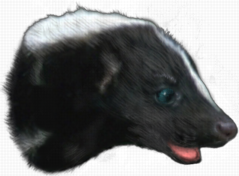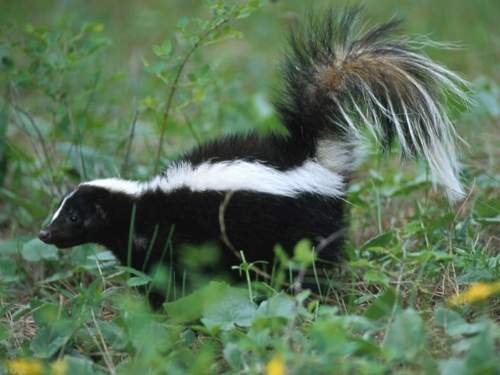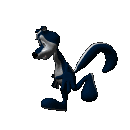
 | TheSkunkStripe Skunk pictures, facts, and much more! |
History
When English explorers and settlers first came to North America, they found many animals that were unlike anything they had ever seen in Europe. One was a small black and white creature that looked like it must be some sort of weasel or mink. Though nocturnal, it wasn't the kind of animal to go unnoticed. Anyone who made the mistake of attacking it, was soon driven off by its absolutely foul smelling form of defense. As with many of the things and places that were new to them, the colonists adopted, and in this case adapted, the name the Native Americans had already given this strange animal. The Algonquian Indian name "seganku," meaning "one who squirts," became the English word "skunk."

Image Source: Erwin C. Nielsen/Painet Inc., Illinois Department of Natural Resources.
Available in two sizes:
1024 x 768 || 800 x 600
Geography
Most skunks are native to the Western Hemisphere. The majority of the skunk species living in Canada, the United States of America, and Mexico. With several species inhabiting the Caribbean islands and all of the South America continent. The exception is the Oriental Stink Badger, which can be found in parts of the Philippines and Indonesia.

Image Source: Photo taken by The Skunk Stripe at the San Bernardino County Museum, with permission.
Available in two sizes:
1024 x 768 || 800 x 600
Appearance
There is no one size for skunks. They can vary in size from the Spotted Skunk that can be the size of a squirrel all the way up to the Hog-nosed Skunk, which can be the size of a small lap dog. Most skunks sport the almost universally recognized pattern of a black body with white stripes. The exact strip pattern can vary with each individual animal, and contrary to folklore it can't be used to determine the skunks gender. Less commonly known is that they can occasionally have a brown body and white stripes or a grey body and white stripes. Some may even be completely white, without being an albino, or a solid black. Unlike most small animals that try to blend with their surroundings to avoid predators, skunks want to be seen. Much like the bright colors of poison dart frogs in the Amazon rain forest, skunks deliberately standout to warn other animals to stay away.

Member of Fohn.net
Privacy Policy

